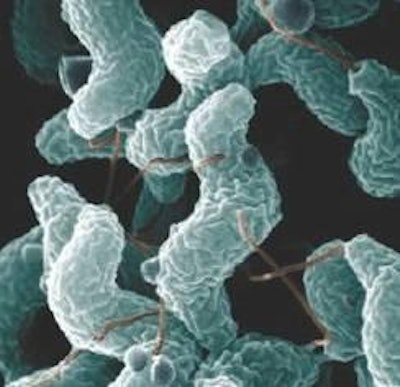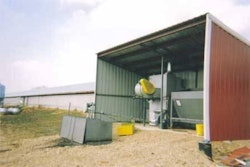
The XIII European Poultry Conference took place in Tours, France, in late August. Amongst the papers presented at the event were an examination of campylobacter contamination, and on farm evaluations of broiler welfare.
Persistent problem
Campylobacter remains the main cause of gastroenteritis among European consumers, and poultry products are very often the source. However, the poultry chain is now looking to control this bacterium in the wake of its success in controlling salmonella.
Gilles Salvat, from the French agency for food, environmental and occupation health safety (Anses) commented: “Great efforts have been made in Europe over the last 20 years, and especially in France, to eradicate salmonella from poultry farms, slaughter and further processing facilities.”
The situation regarding salmonella across Europe remains patchy, but some countries have been able to bring the bacterium firmly under control within the poultry industry. However, this has not been the case with campylobacter.
Routes of contamination
Within slaughterhouses, contamination it primarily due to two factors, the degree to which good hygiene practices are followed, and the microbiological status of the birds received. Once meat leaves the slaughterhouse, cross contamination tends to occur at consumer level through the spread of bacteria from contaminated meat to the surfaces where it is prepared.
While the factors contributing to the infection of live birds with salmonella and campylobacter may be very different, the measures required to control them at slaughterhouse and at consumer level are similar.
Salmonella and campylobacter are bacteria originating in the gut and not from surfaces. Overcrowding has been clearly identified as a risk factor for campylobacter contamination in many studies. The cleaning and disinfection of transport crates is a critical control point for controlling contamination.
Scalding is another critical point. A hard scalding seems to lower contamination rates, but to increase further contamination, perhaps due to the better adhesion of bacteria to damaged skin, while a soft scalding increases immediate contamination, but decreases further contamination during washing. The use of a scald additive, for example 1% sodium hydroxide, reduces contamination, however this is banned in Europe.
Defeathering can also be a point of contamination, due to plucking finger hygiene, fecal material released from the cloaca, the contamination of feather follicles by soiled water from the scalding tank, airborne contamination due to the aerosol made by water droplets and removal of the cuticle during plucking in the case of hard scalding.
Evisceration also increases the risk of contamination – more than 50% of carcasses are soiled following crop or gut leakage.
“Efforts have been made to improve slaughter techniques to reduce contamination of carcasses, however, the origin of contamination remains with live birds,” continued Gilles Salvat.
Lupo Ellerbroek of Germany’s BSFH noted that the screening of broiler flocks for campylobacter on farm, and at slaughter, could help to identify hygiene control points.
A study across three German regions of 51 broiler flocks looked for thermophilic campylobacter. 45% of flocks were found to be contaminated, with the highest contamination rate being recorded during June, July and August. The study found no horizontal contamination from one flock to the next via persistent contamination in housing.
Sampling during processing confirmed that the entrance of a positive flock resulted in the contamination of the abattoir environment. Campylobacter spp were isolated from all sampling stages along the processing line.
New welfare approaches
Delegates were also told about the Welfare Quality project, a monitoring system for farmers and researchers based on birds’ perceptions and how they cope with their environment.
European consumers still believe that production animals, especially poultry, are not kept in conditions that respect their welfare. A Eurobarometer survey conducted in 2005 revealed that 82% of those surveyed ranked farm animal welfare as bad or very bad, with poultry welfare consistently scoring worse than that of pigs or cows.
One of the industry’s responses to consumers’ animal welfare concerns has been the adoption of quality labels such as the UK’s Freedom Food or France’s Label Rouge. However, European regulations are now also addressing the area. There are six non-binding recommendations that have been issued by the Council of Europe, and two EU Directives, one for laying hens and one for broilers.
However, according to Cecile Arnould of the French National Institute for Agricultural Research (Inra) it was felt that a robust on-farm welfare monitoring programme should be developed with requirements for specific species, and this was one of the aims behind the project “Welfare Quality”, co-funded by the EU.
Animal focus
The system that has been developed is focused on animal, rather than on environmental or management factors, and welfare is managed according to four principles - good feeling, good housing, good health, and appropriate behaviour. For each of these principles, several criteria have been adopted, such as thermal comfort for good housing or absence of injuries for health.
Practical measures to allow the evaluation of these criteria have been selected and tested on 90 commercial farms from three countries and across three different production systems to assess on-farm feasibility of the protocol.
This new scheme differs from some existing systems, and takes into account the environment of the animal, as is the case with the Animal Needs Index in Austria, and the Swedish welfare programme for broilers, which evaluates both a bird’s environment and management.
The link between environmental and animal-based measures is not always obvious. For example, several studies in broilers have shown that the link between stocking density and welfare measures, such as contact dermatitis, for which the main risk factor is poor litter quality) is not direct. Ventilation, temperature, humidity and litter are more important than, for example, stocking density alone.
Examining bird behaviour and pathology could be more relevant, yet measures applied directly to the bird may not always be enough. For chicken, the most well known system is the foot-health program, which was developed in Sweden and is also used in Denmark. If focuses on the prevalence and severity of foot-pad dermatitis, but fails to cover all aspects of animal welfare.
Stakeholder agreement
The European Welfare Quality project comprises a monitoring system focusing on measures applied to birds as the most important aspect in considering how animals perceive and cope with their environment. To gather additional information, poultry producers must answer questions on housing and management practices, amongst other areas, and the analysis of this data can be fed back to improvement welfare management practices.
As welfare is a multidisciplinary concept, several criteria should be taken into account to assess it properly.
Four measures have been drawn up to evaluate animal welfare: good feeling, good housing, good health, and appropriate behaviour. These measures are exhaustive, minimal, and agreed by stakeholders, and their interpretation is independent.
For each of these four princiles 12 criteria have been defined and presented to consumer/citizen focus groups for approval. They include: absence of prolonged hunger and thirst for the first one, comfort around resting, thermal comfort and ease of movement for the second, absence of injury, disease and pain induced by management procedures for the third, and expression of social and other behaviours, good human-animal relationships and a positive emotional state for the fourth.

















